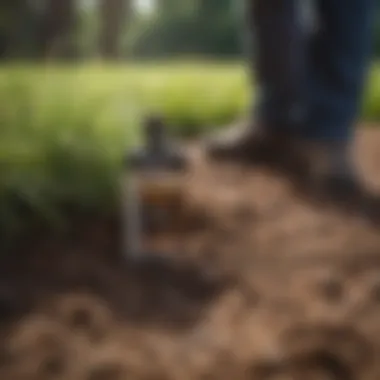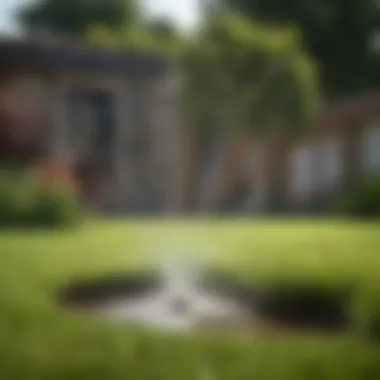Effective Strategies to Repair Brown Grass


Intro
Brown grass is a widespread problem that many homeowners face. It often indicates underlying issues that need attention. Whether it is due to improper watering, nutrient deficiencies, or pest invasions, understanding these factors is critical for effective lawn repair. This article serves as a detailed guide to diagnosing and resolving the various causes of brown grass, helping restore your lawn's vitality.
In the following sections, we will delve into the essential steps to begin your recovery journey. From soil health assessments to appropriate watering techniques, we cover it all. By applying the strategies discussed here, you can enhance your outdoor space's aesthetic appeal while ensuring your grass thrives.
Design Inspirations
Although brown grass is often an eyesore, it does not mean your garden lacks beauty. Recognizing how to approach a rejuvenation plan can provide not just practical fixes but also a foundation for future lawn design.
Trending Styles
Think of your lawn as an extension of your living space. Modern landscaping emphasizes clean lines and sustainable practices. It is essential to consider incorporating drought-resistant grass varieties if water availability is a concern. This choice can minimize brown patches while maintaining the overall design. Additionally, you might explore ornamental grasses that complement a healthy lawn, adding texture while standing up to environmental stressors.
Color Palettes
Colors in your landscape can influence perception. A vibrant green lawn can serve as a backdrop for colorful flower beds and decorative stones. When working with brown grass, choose embedded plants and foliage that rejuvenate your design. A harmonious blend of greens, purples, and yellows can enhance the visual appeal, even amid decline.
Maintenance and Upkeep
Building a regimen around lawn care is vital to preventing brown grass before it happens. The ongoing upkeep directly influences the longevity and health of your grass.
Seasonal Maintenance Checklist
- Spring: Test soil for nutrient levels. Aerate the soil if compacted. Seed bare patches.
- Summer: Monitor watering habits. Adjust frequency around heat waves. Apply organic fertilizer to promote growth.
- Fall: Prepare grass for dormancy. Reseed as needed and mulch leaves instead of removing them.
- Winter: Limit foot traffic to minimize stress on dormant grass. Assess and prepare tools for spring cleanup.
Cleaning and Organization Tips
- Keep lawn tools in good repair. This ensures preparedness whenever maintenance is needed, helping maintain efficiency.
- Regularly remove debris and fallen leaves. This prevents moisture retention that can lead to disease and brown patches in grass.
- Organize your schedule for lawn care like fertilization and watering. This creates a sustainable routine, crucial for long-term maintenance.
Proper lawn care is not just about the grass; it involves a holistic approach to garden aesthetics and environmental stewardship, ensuring balance.
Intro to Brown Grass
Brown grass can be an alarming sight in any yard. For homeowners, its presence often indicates a deeper issue with lawn care. Understanding brown grass paves the way for effective remedies and maintenance routines. This section is vital in setting the stage for the entire article. It allows readers to identify what brown grass means and why addressing it matters.
A healthy lawn is not only visually appealing but also contributes to the overall ecosystem. Proper care ensures that grass remains green and vibrant. In contrast, brown grass can indicate stress for the plant, potentially leading to longer-term damage if not treated correctly.
The forthcoming subsections will delve into definitions and causes which play a significant role in understanding this problem. Recognizing the various facets—both visible characteristics and underlying factors—will greatly assist in diagnosing and rectifying the issues related to brown grass.
Understanding Brown Grass
Brown grass is often a symptom of distress in lawn conditions. It is typically the result of environmental stressors or improper maintenance practices. Key indicators include dryness, wilting, or patchy areas of grass that lack color. Grass can turn brown for various reasons, including inadequate watering, poor soil health, pest attacks, or environmental shifts. Identifying brown grass early can help homeowners take corrective actions before the problem worsens.
Common Causes of Brown Grass
- Environmental Factors
Environmental conditions are often the first culprits in grass health decline. Droughts, excessive heat, or cold snaps can contribute significantly to the stress of the grass. Environmental shifts lead to changes in moisture levels, which affects grass color and health. Grass under stress due to the weather can show signs of wilting, fading, or brown patches. While some environmental factors are beyond control, recognizing their impact is crucial for effective lawn management. - Soil Issues
Soil quality plays a vital role in grass health. Compacted soil can limit root growth and water absorption, leading to dry patches. Poor soil can also lack essential nutrients, which the grass requires to thrive. Testing the soil's pH and nutrient levels can help homeowners understand if the soil is contributing to the brown grass. Improving soil conditions, through aeration or adding organic matter, can have a beneficial impact on restoring grass color and vitality. - Pest Infestation
Pests are often hidden yet destructive. Insects such as grubs or chinch bugs can damage roots and diminish the grass's ability to absorb water and nutrients. These pests cause localized brown patches that can expand quickly if not addressed. Keeping an eye out for these signs and applying appropriate pest control methods can protect against further losses. Identifying and treating pest infestations early is essential in preventing widespread damage. - Improper Watering
Watering habits can either save or jeopardize a lawn. Both under-watering and over-watering can lead to brown grass. Short watering schedules may not allow grassroots to establish properly, while over-watering can lead to root rot and fungal issues. Knowing how much and how often to water is vital; lawn should receive enough water but not become soggy. Establishing a consistent watering schedule can go a long way in keeping the grass healthy. - Grass Type Sensitivity
Different grass types respond uniquely to environmental conditions. Some varieties are more tolerant of heat and drought, while others thrive in cooler temperatures. Homeowners need to choose grass types suitable for their region’s climate. If the wrong variety is planted, it may show signs of stress sooner than expected. Being aware of the local climate can help in selecting the right grass type, which in turn supports the lawn’s resilience against brown patches.
Dealing with brown grass is a common struggle, but by understanding these critical causes, homeowners can take actionable steps toward recovery and maintenance.
Diagnosing the Problem
Diagnosing the problem of brown grass is a critical step in the restoration process. It is not enough to simply apply products or alter watering habits without understanding the root cause. Every lawn is unique, and various factors can influence grass health. A systematic approach leads to effective solutions. By identifying underlying issues, you can tailor a repair strategy that addresses specific needs of your lawn.
Knowing how to conduct a thorough diagnosis helps prevent wasting time and resources on ineffective methods. It allows homeowners to pinpoint exact problems, enabling them to rectify those issues with targeted actions. Therefore, investing effort in diagnosing is crucial for achieving a healthy and vibrant lawn.
Visual Inspection Techniques
Visual inspection is the first step to understanding lawn health. It involves looking closely at your grass to identify patterns of discoloration and stress. Observe the color and texture of the blades. Are they uniformly brown, or do you see patches?
Pay attention to the soil around the grass. Is the soil compacted or dried out? Checking for signs of pests like grubs or worms is also essential. These visual cues will give you immediate insights into possible causes, guiding further exploration.
Conducting a Soil Test
Performing a soil test provides more detailed information. It helps to assess factors such as pH levels, nutrient availability, and organic matter content. Each aspect contributes significantly to grass health. Understanding these factors allows for informed decision-making regarding amendments and care.


Testing pH Levels
Testing pH levels is important for determining soil acidity or alkalinity. The pH balance affects nutrient absorption in grass. A highly acidic or alkaline soil can hinder grass growth and cause browning.
Key characteristics of testing pH levels include its straightforward process and availability of testing kits. It is popular because a well-balanced pH range of about 6.0 to 7.0 promotes optimal grass health. This test can show if you need to add lime to raise the pH or sulfur to lower it. A disadvantage is that it requires proper interpretation of results and can be influenced by other soil issues.
Nutrient Deficiency Assessment
Nutrient deficiency assessment evaluates if your grass is lacking essential nutrients. Grass can display brown patches when nitrogen, phosphorus, or potassium levels are low.
A key characteristic is that nutrient assessments often reveal specific deficiencies, allowing targeted fertilization. It is beneficial because knowing exactly what nutrients are lacking can lead to significant improvement in lawn health. However, if misdiagnosed, it can result in applying wrong fertilizers, which harms the grass.
Organic Matter Evaluation
Organic matter evaluation looks at the quality of soil structure and microbial activity. Higher organic content often promotes healthier grass. This evaluation focuses on compost levels and humus present in the soil
It is a beneficial choice because organic matters improve soil aeration and water retention, promoting healthy grass growth. A unique feature is that it requires analyzing the soil’s texture and color. The disadvantage includes the need for time-consuming methods such as composting or soil amendments, which can delay immediate results.
Watering Techniques
Watering techniques play a crucial role in restoring brown grass. Understanding how to appropriately hydrate your lawn can directly impact its health. The right approach to watering not only aids grass recovery but also conserves water and prevents diseases. Different lawns have varying needs, depending on factors such as soil composition, grass types, and climate conditions.
Determining Water Needs
To determine the proper water needs of your lawn, consider several key factors. First, assess the soil type. Sandy soils drain quickly and need more frequent watering, while clay soils retain moisture and require less. Always monitor the grass's color and health. If grass turns gray or looks wilted, it is time to water. Accurate measurement of water needs ensures that the grass receives sufficient hydration without becoming overwatered.
Remember: Overwatering can lead to root rot and fungal diseases. Monitor the moisture level in the soil to achieve optimal watering.
Watering Schedule Tips
Morning vs. Evening Watering
Morning watering is generally preferred for most lawns. Water applied early allows the grass to absorb moisture before the heat of the day. In contrast, evening watering can lead to prolonged dampness, making grass susceptible to fungal diseases. Therefore, morning watering stands as a reliable method.
Key characteristic of morning watering is its effectiveness; this strategy reduces evaporation loss. It also allows grass blades to dry before nightfall, minimizing disease risks. For lawns, morning watering is often seen as the most beneficial choice. However, extreme heat can necessitate adjustments.
Deep Watering Techniques
Deep watering techniques emphasize saturating the lawn to a depth of six to eight inches. This method promotes deeper root growth, which helps grass withstand drought and heat stress. A significant advantage of deep watering is that it encourages a robust root system. Lawns with well-established roots require less frequent watering, conserving overall water usage.
To implement deep watering, consider using a soaker hose or a sprinkler with a timer. Make sure to allow water to seep deeply into the soil with less frequency rather than short, frequent sessions. The primary advantage is long-term grass health, although deep watering takes more time and potentially more resources compared to frequent shallow watering.
Overall, understanding and implementing effective watering techniques can significantly improve lawn health and combat the occurrence of brown grass.
Soil Health Improvement Strategies
Maintaining the health of the soil is critical when dealing with brown grass. The soil serves as a foundation for plants, supplying essential nutrients, water, and air. Improving soil health can enhance its structure and fertility, which are vital for a vibrant lawn. By employing effective strategies to boost soil health, homeowners can pave the way for successful grass recovery.
Aeration Methods
Aeration is key to promoting better root growth. It allows air, water, and nutrients to penetrate the soil more effectively, reducing compaction.
Manual Aeration
Manual aeration involves the physical process of extracting soil plugs from the ground. This method is useful for small lawns and offers a direct approach to alleviating soil compaction. One key characteristic of manual aeration is its simplicity. Homeowners can use a hand aerator or a garden fork to perform the task.
This method is beneficial because it gives a precise control over how much soil is aerated. However, the drawbacks include the physical effort required, and it may not be effective for larger lawns due to time constraints. Overall, manual aeration contributes significantly to improving soil penetration, which can help rejuvenate brown grass.
Mechanical Aeration
Mechanical aeration utilizes powered equipment, such as aerators or lawn mowers designed for this purpose. This method is particularly effective for larger lawns where manual aeration may be impractical. A key characteristic of mechanical aeration is its efficiency; it can aerate a vast area in a relatively short period.
The unique feature of mechanical aeration is its ability to pull larger core samples from the soil. This leads to deeper aeration and less surface disturbance. On the downside, this equipment can be costly to rent or purchase, and it may leave small holes that visually disrupt the lawn in the short term. Nevertheless, the benefits of improved soil aeration can outweigh these concerns.
Adding Organic Matter


Incorporating organic matter into the soil nurtures it and improves its structure. Organic materials enhance microbial activity, which is essential for nutrient availability.
Compost Application
Compost application involves spreading decomposed organic matter across the soil surface. This practice adds essential nutrients back into the soil, fostering a fertile environment for grass growth. One major benefit of compost application is its ability to improve moisture retention. It enriches the soil, which can be crucial for brown grass recovery.
Additionally, compost is easy to obtain and apply, making it a popular choice among homeowners. One disadvantage is that compost application may take time to break down and fully benefit the grass. However, its long-term effects on soil health are well worth the wait.
Mulching Benefits
Mulching involves covering the soil with a layer of organic material, such as grass clippings or leaves. This method helps to retain moisture and suppress weeds, providing a healthier environment for grass. A notable characteristic of mulching is its dual purpose. It not only enhances soil structure but also reduces the need for additional watering.
Mulching can be highly beneficial, especially during warm seasons, as it helps to keep the soil cool. However, if mulched materials are not managed properly, they might harbor pests or diseases. Overall, the advantages of mulching significantly contribute to improving the overall health of the soil.
Fertilization Practices
Fertilization practices are vital for maintaining a healthy lawn. The right fertilizer can revive brown grass, giving it the nutrients it needs to grow vigorously. Applying fertilizer helps replenish the soil's nutrient levels, ensuring that your grass receives adequate elements for photosynthesis and overall health. Without proper fertilization, even the best watering and soil care efforts may go to waste. Thus, understanding how to select and apply fertilizers effectively is a critical aspect of grass repair.
Choosing the Right Fertilizer
Organic vs. Synthetic
There are two main types of fertilizers: organic and synthetic. Organic fertilizers come from natural sources, such as animal manure or compost. They enhance soil structure while releasing nutrients slowly over time. This characteristic promotes long-term soil health and improves microbial activity, which is essential for your grass's overall health.
On the other hand, synthetic fertilizers are chemically manufactured and provide nutrients quickly. They often contain concentrated levels of key nutrients like nitrogen, phosphorus, and potassium. While this leads to rapid growth, it may lead to nutrient leaching if not properly managed. Homeowners should consider their long-term goals when choosing.
Organic practices lead to sustainable lawn care, but synthetic options can sometimes offer immediate results. It depends on your gardening philosophy and lawn care goals.
N-P-K Ratios Explained
Understanding the N-P-K ratio is crucial for selecting the appropriate fertilizer. N-P-K stands for nitrogen (N), phosphorus (P), and potassium (K), the three primary nutrients essential for grass.
- Nitrogen promotes lush growth and green color.
- Phosphorus supports root development and flower production.
- Potassium helps with disease resistance and overall lawn strength.
Each fertilizer bag displays this ratio, such as 20-10-10. Here, the numbers represent the percentages of each nutrient. Selecting a fertilizer based on these ratios can significantly impact the health of your lawn. For example, a higher nitrogen ratio can be beneficial for green grass, while balanced ratios may be ideal for overall lawn health.
Fertilization Schedule
Creating a strategic fertilization schedule is just as important as choosing the right fertilizer. Timing your application can optimize nutrient absorption and growth. Fertilizing in early spring helps kick-start growth after winter dormancy. A second application in late summer can prepare your grass for the upcoming colder months. Stick to recommended rates to avoid over-fertilization, which can cause more harm than good. Whether you use organic or synthetic options, boosting your lawn's nutrient profile regularly will help in achieving those vibrant results.
Dealing with Pests and Diseases
Addressing pests and diseases is a key part of maintaining a healthy lawn. These issues can swiftly turn vibrant green grass into brown patches if left unattended. It is crucial to identify and treat these problems early to prevent further damage. Regular monitoring of the lawn can save time, effort, and resources over the long term. Therefore, understanding how to identify and deal with both pests and diseases is essential in any repair strategy for brown grass.
Identifying Pest Problems
Pests can wreak havoc on your lawn without many visible signs at first. Regular checks can help homeowners catch these issues early. Look for symptoms such as irregular patches of discoloration, uneven growth, or even the presence of insects on the grass.
A simple inspection can reveal common lawn pests like grubs, chinch bugs, and armyworms. Their feeding habits can lead to significant damage. For instance, adult grubs work on grass roots, which can weaken the plant. Once identified, it’s easier to choose an effective treatment. This could include using natural predators such as beneficial nematodes or applying insecticides when necessary.
Common Lawn Diseases
Understanding lawn diseases helps in preventing and addressing brown grass. A few diseases are more common than others and can lead to substantial damage.
Fungal Infections
Fungal infections are a major concern in turf management. They thrive in warm, moist conditions, which many homeowners may unknowingly encourage. Key characteristics of fungal infections include circular brown patches or a discolored overall appearance.
These infections can spread quickly and damage grass more extensively if not treated.
A unique feature of fungal infections is their ability to remain dormant in the soil, re-emerging when conditions are favorable for growth. This makes awareness and prevention crucial. Treatments commonly involve fungicides or changing watering practices to reduce excess moisture in the lawn. The advantage of tackling fungal infections promptly is that it often leads to a quicker recovery of the grass and minimizes the spread.
Bacterial Issues
Bacterial issues can also impact lawn health. They are often less visible than fungal infections but can be equally destructive. Key characteristics of bacterial pathogens include slimy patches or streaks on the grass blades. Unlike fungi, bacteria can often thrive in cooler conditions.


One unique feature of bacterial diseases is their ability to affect soil quality. Over time, certain bacteria can lead to nutrient deficits in the soil, making recovery more challenging. Engaging in practices like soil testing can help identify nutrient imbalances related to bacterial issues. The advantage of understanding these problems is that it enables homeowners to implement tailored soil treatment methods, improving overall lawn health over time.
"Early identification of pests and diseases can save not just your lawn's appearance, but its overall health too."
In summary, recognizing the threats posed by pests and diseases is crucial for restoring your grass. With proper knowledge and timely interventions, homeowners can effectively mitigate these issues. Addressing these problems promptly can prevent brown grass, ensuring a lush, vibrant lawn.
Proper Lawn Care Practices
Maintaining a healthy lawn is vital to preventing brown grass and enhancing the overall appearance of your outdoor space. Proper lawn care practices encompass techniques that contribute to the vigor of grass, ensuring it remains lush and green. Here, we will dissect the integral aspects of mowing techniques and weed control methods, illustrating their importance and benefits.
Mowing Techniques
Mowing is a fundamental aspect of lawn care, influencing not only the grass appearance but also its health.
Optimal Cutting Height
Optimal cutting height refers to the recommended height at which grass should be mowed. This height varies depending on the type of grass; however, as a general guideline, most grasses thrive when cut to about two to four inches. Keeping grass within this range allows for sufficient leaf area to capture sunlight, facilitating effective photosynthesis. Grass mowed too short may initiate stress, leading to brown patches.
- Key Characteristic: The ability for grass to maintain adequate chlorophyll levels and moisture retention.
- Benefits: Prevents lawn stress and supports deeper root development.
- Unique Feature: Adjusting the height based on seasonal growth can enhance grass resilience against diseases and pests.
Frequency of Mowing
The frequency of mowing needs to align with the grass growth rate. During the growing season, typically from spring to early summer, lawns may require mowing once a week. However, a longer interval may suffice during fall and winter. Proper frequency ensures that the grass does not become too tall, which can inhibit light penetration and promote thatch buildup.
- Key Characteristic: Maintains grass health by preventing excessive height and the risk of pests.
- Benefits: Promotes even growth and a uniform lawn appearance.
- Unique Feature: Adjusting mowing frequency enables homeowners to adapt to changes in weather and soil conditions, potentially reducing the risk of brown grass.
Weed Control Methods
Weeds can compete vigorously with grass for nutrients, water, and light. Effective weed control methods are essential in keeping your lawn healthy.
- Cultural Practices: Promote densely planted grass to outcompete weeds.
- Mechanical Control: Hand-pulling or hoeing can be effective for small areas.
- Chemical Control: Selective herbicides target specific weeds without harming grass. Careful application ensures minimal impact on beneficial organisms in the lawn ecosystem.
"Controlling weeds effectively can significantly contribute to a healthier, greener lawn."
Seasonal Considerations
Understanding the role of seasonal changes is critical when dealing with brown grass. Each season brings specific challenges and opportunities for lawn maintenance. By adjusting your care routine according to the season, you can improve the health and appearance of your lawn effectively. Seasonal considerations influence factors like watering, fertilization, and pest control. Therefore, a tailored strategy for each period can lead to a more successful recovery and maintenance of green grass.
Spring Recovery Strategies
Spring serves as a renewal phase for your lawn. As temperatures rise, grass begins to grow actively again. To support recovery during this time, several strategies can be employed:
- Aerate the Soil: This process allows air, water, and nutrients to penetrate deeper into the soil. Aeration reduces compaction, improving the overall health of the roots.
- Fertilize Wisely: Use a balanced fertilizer tailored for the spring. Look for one with a higher nitrogen content to promote green, lush growth.
- Introduce Resilient Grasses: Consider overseeding with hardy grass types that adapt well to your local climate. This can replace poor areas and encourage dense growth.
- Monitor for Pests: As the weather warms, pests become active. Regularly inspect your lawn for signs of infestation.
Summer Maintenance Tips
Summer can be challenging due to heat and potential water restrictions. However, maintaining your lawn during this season is crucial to avoid long-term damage. Here are key maintenance tips:
- Adjust Watering: Establish a deep watering routine, ensuring to water early in the morning. This helps prevent evaporation and allows the grass to develop deeper roots.
- Mow Regularly: Keep your grass at an optimal height. Higher grass blades can provide shade to the soil, which helps retain moisture and resist heat stress.
- Limit Fertilization: Too much fertilizer during hot months can burn your lawn. Use slow-release fertilizers and apply them sparingly.
- Watch for Heat Stress: Grass can become dormant due to high temperatures, appearing brown. This is a natural defense mechanism. Only resume normal care once temperatures drop.
Preparing for Fall and Winter
The transition into fall and winter is a pivotal time for lawn care. Effective strategies during this period can set the stage for a healthy recovery in spring:
- Clean Up: Remove debris such as leaves and branches. This prevents mold and disease while allowing the grass to breathe.
- Apply Winter Fertilizer: A phosphorus-rich blend can strengthen roots and prepare the lawn for winter dormancy.
- Reseed Areas: Fall is an excellent time to overseed with cool-season grasses. This will enable your lawn to fill in bald patches before winter.
- Limit Foot Traffic: Avoid stressing the lawn during winter when grass is dormant and more susceptible to damage.
Adopting these seasonal strategies can make a considerable difference in combating brown grass. The key lies in adapting your approach to the specific needs of your lawn throughout the year.
Closure
In addressing the dilemma of brown grass, a thorough understanding of all the discussed topics is essential. The processes outlined in this article guide homeowners through a systematic approach to diagnosing and repairing their lawns. Recognizing the causes of the brown grass, from soil health to pest management, provides the groundwork for effective solutions. Thus, the conclusion serves not just as a summary but as a pivotal reminder of the interconnectedness of these elements.
Recap of Key Steps
To ensure a successful recovery for brown grass, follow these key steps:
- Assess Factors: Examine environmental conditions, soil quality, water practices, and any signs of pests.
- Conduct Tests: Execute soil tests to identify pH, nutrient levels, and organic matter content.
- Adjust Watering: Implement deep watering techniques to promote strong root development, resulting in a healthier lawn.
- Improve Soil: Aerate the lawn and apply organic matter to enhance soil structure and fertility.
- Fertilize Correctly: Select the appropriate fertilizer type and establish a fertilization schedule tailored to grass needs.
- Monitor Pests: Regularly inspect lawn for pest and disease signs, addressing issues promptly.
Encouragement for Ongoing Lawn Care
Maintaining a vibrant lawn requires consistent work and dedication. Regular lawn care practices like proper mowing, overseeding, and adapting to seasonal changes contribute to a thriving landscape. As you finish the repairs, remember that lawns evolve; continual learning and adjustment are essential.
Utilize your newfound knowledge wisely. Regularly monitor your lawn's condition, apply what you've learned, and don’t hesitate to consult expert resources or local advice. By fostering a mindful approach to lawn care, you invite a rich, green environment that enhances both your property value and enjoyment of outdoor spaces.







